

 |
 |
 |
Guest - Not logged in | |||||||||||||||||||||||||||||||||||||||||||||||||
Reviews > Packs > Internal and External Framed Backpacks > Lowe Alpine Nanon 50 60 Pack > Test Report by Ben MansfieldLowe Alpine Nanon Backpack
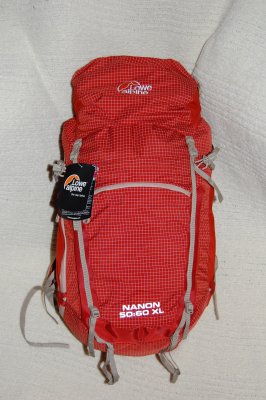
Lowe Alpine Nanon in Ochre
Backpacking Background Over the past 15 years or so, I've tried to average at least one weekend trip per month year round, primarily in Pennsylvania, West Virginia, and Virginia. During the last 8 years, I've tried to take a week long trip somewhere further, but still usually in the eastern US. I consider myself a mid-weight hiker, preferring some luxury to an ultralight load. I am also an avid fly fisherman, mountain & road biker, and snow skier, and enjoy sailing my homemade dinghy. Initial Report20 September 2009 Product Information 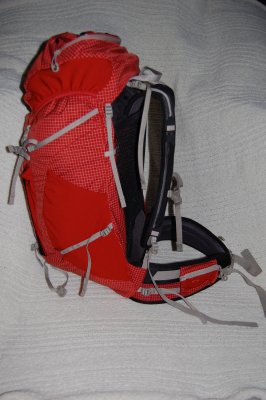
The Lowe Alpine Nanon
Product Description The Nanon is one of Lowe Alpine's newest additions, and is targeted towards folks like me - backpackers aspring to live in the ultralight world, but unwilling to compromise on features. Lowe Alpine says this pack is 3 lbs 1 oz (1.49 kg), and my scale puts it at a scant 3 lbs 3 oz (1.4 kg) - making it plenty light - and with a full compliment of useful features, it looks like it should live up to its goal. The pack material itself is Dyneema - mine came in an attractive, deep red color that Lowe Alpine calls ochre, complimented by an array of thin white threads covering the pack with a ¼ in (0.6 cm) square grid. The men's Nanon is also available in two other colors - a bright green called dark pear, and dark aqua, an attractive blue color. Lowe Alpine offers the men's pack in two sizes - the normal 50:60 (referring to the volume - more on that below) and a 50:60 XL. The only real difference, besides a few ounces, is the size and adjustment range of the harness. The standard 50:60 fits folks with a torso length of 16 - 21 in (40 - 53 cm), and the 50:60 XL covers the range of 18 - 23 in (46 - 58 cm). Lowe Alpine rates the carrying capacity of the Nanon as 22 - 33 lbs (10 - 15 kg).
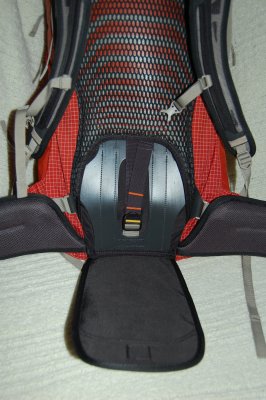
Adjusting the Nanon The internal frame structure is comprised of a rigid plastic framesheet along with a 1/8 in (3 mm) U-shaped metal rod running the length of the backpanel, with the bottom of the U at the top of the pack (observable by opening a small flap secured with a hook-and-loop closure. The metal rod appears to be removable, but I did not try as the fit is quite snug.
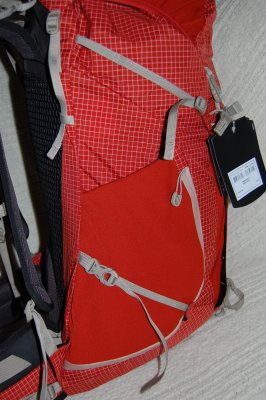
Zippered Side Entry The top lid is secured by two quick clips on the front of the pack in the traditional way, and the back side is secured in place and height adjustable thanks to a pair of adjusters and some webbing. Because of the installation method, the top lid is removable, but I'm not enough of a weight weenie to have ever found the need to remove a backpack's lid before. There are two sets of lashing points on the top of the lid, each with two loops sewn into the hood on the flap that's made by the semi-circular main zipper. Unzipping said zipper allows access into the somewhat large top pocket, and also reveals a key keeper clip sewn onto a short piece of webbing. Flipping over the top lid reveals two things - a bright orange zipper and instructions, printed in English, German, and French, for signaling for help in alpine settings. This is actually kind of neat, hopefully if I ever need to use the signals shown (such as whistle blows, light signaling, emergency phone numbers on several continents, and how to flag down a helicopter) I'll remember my Boy Scout training and not have to refer to the underside of the Nanon's top lid. Just in case I forget, though, it's there for me. I suppose it might also be helpful were someone to find me injured - the rescuer could potentially use the instructions. The orange zipper provides access to another pocket in the lid - this one somewhat smaller than the main pocket on the outside.
I originally noticed the attention to detail that Lowe Alpine puts into their backpacks the first time I looked inside of the top pocket. Every seam is reinforced with what looks to my untrained eye like nylon grosgrain ribbon folded over the seam and sewn in place. Zippers are cleanly installed, and there is fabric reinforcement and substantial bar tacks in places like where the lash points are sewn down.
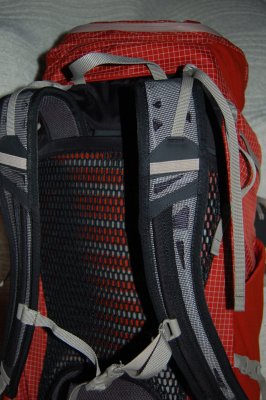
The mesh-covered backpanel and the cutouts in the shoulder straps The Nanon's waist belt is sufficient, with padding only where it will be needed the most to save weight. Lowe Alpine calls the hipbelt on the Nanon a lightweight version of their popular AdaptiveFit™ hipbelt. Besides the fastener around my waist, there is also an adjustment towards my back for pulling the pack's load in closer to my body. Each side of the hipbelt includes a pocket measuring approximately 4 ½ in x 3 ½ in (11 ½ cm x 9 cm) - big enough to put a small snack, my GPS, or other small accessory. One thing to point out here is that while I'm more or less in the middle of the torso range for the XL version of this pack, I have to snug the hipbelt almost as tight as it will go to get it in the right place for me. While it won't be a problem for me since I can get it tight enough, it may cause issues for other folks who may be tall (or have a long torso) and very thin. As a point of reference, my waist is about 33 or 34 in (84 to 86 cm)... maybe even a little smaller right now, but that won't last long as we head into winter (gotta stay warm - a little winter weight never hurt anyone).
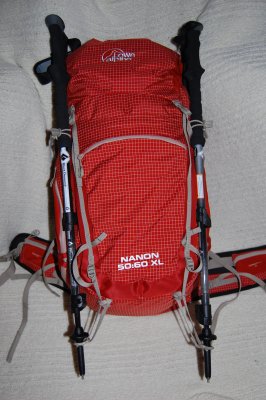
Finally! A way to actually secure my trekking poles Also along the front stuff pocket are parallel, vertical strips of webbing which can do all kinds of jobs. First, the tops of the webbing hold the male ends of the quick clips used to secure the top lid in place. Next, the webbing is bar-tacked down in four places, forming three lashing points on each side. Next, the remainder is fed down through a series of adjustments and eventually looping through a circular piece of plastic meant to secure the tips of my trekking poles. Lacking trekking poles, the webbing loops could also be used as ice axe loops, or even open up wide enough to secure most rolled up sleeping pads (both of mine fit, but a really thick one may not). In my case, trekking poles will be the majority case, and the little plastic pieces hold the tips very securely. So securely, in fact, that I'm hoping that they loosen up a little bit over time. I'm not complaining, though, because it's generally pretty hard to really secure trekking poles to most packs. The other end of the poles (or ice axe, if that's your pleasure) get secured by a pair of elastic bands with a hook located at the top corners of the stuff pocket.
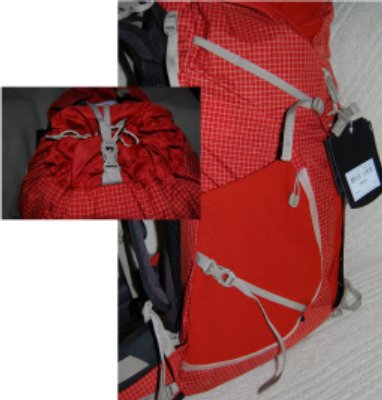
The side & top compression straps The inside of the Nanon is one big compartment, save for a thin hydration pocket that runs along the backpanel. There's also the access flap which allows a peek at the pack's frame that I mentioned above as well. There is no separate sleeping bag compartment or any other form of division within the main pack. The hydration pocket is huge, and easily fit my 2 L (64 oz) bladder. I don't have a larger one to try, so I won't speculate on how large of a bladder I could fit. Suffice it to say, though, that there's plenty of room left over after fitting my hydration bladder in there. An overlapped cutout above my right shoulder allows the drinking tube to escape the main pack body while still maintaining reasonable protection from the elements. The pack arrived lacking instructions but with a hang tag detailing the warranty and a nice story about the history of Lowe Alpine. The warranty provides a guarantee for the lifetime of the Nanon, and excludes the normal things like misuse and natural wear and tear. About the only other thing I haven't mentioned is the haul loop. Yep, there's a haul loop (also known as the thing I use to hang my backpacks on the wall in my gear room / man cave). Some other things I noticed immediately with the Nanon is that the webbing used everywhere is thin... much thinner than I'd expected and thinner than that used on similar backpacks. Knowing what I know about webbing, however, this doesn't concern me in the least. Webbing is some tough stuff, and there's no sense wasting weight on overspecified materials. The other thing I noticed is that the bottom of the back is not reinforced - it uses the same Dyneema fabric as the rest of the pack body, nor is there a separate set of lashing straps across the bottom - commonly provided for lashing on a sleeping pad or other long cylinders. Neither bother me - I'll either use a sleeping pad which can go inside or use the straps on the front of the Nanon (at the trekking pole connector), and will just watch where I put it down in the woods. Initial Impressions The Nanon is awesome. That's my initial impression in a sentence. When it arrived the box was so small and light I gave it to my wife, assuming it was something she'd ordered. Closer inspection of the shipping label got me excited, and when I opened it up I thought that Lowe Alpine sent me the wrong pack it was so small. After I got it all un-compressed and stuffed full of gear, however, I came to realize that this backpack is indeed the correct size and a very attractive pack to boot. As I slowly went over the Nanon, I was excited to find feature after feature, all complemented by excellent construction and appropriate material choices. Fitting the Nanon to me was a pretty fast process, once I figured out that the adjustment strap is hidden behind the lumbar pad. I set the adjustment to my color code based on Lowe Alpine's Torso Fit System, put the pack on and made all of the necessary adjustments to the suspension. With some weight in the pack the torso length was a little long, so I took the Nanon back off, shortened it up a bit, and refit the pack... Aahhh... nice. I can't wait to get the Nanon into the woods for some backpacking. Given the size and load rating, it's the perfect size for most of the trips I'll take. And with the Nanon's target audience being almost a word-for-word description of me, I'm excited to see if they've met their goal of providing a lightweight backpack for aspiring ultralighters unwilling to compromise on features. Field Report24 November 2009 Field Conditions
Nanon stuffed to the gills alongside a beautiful glacial lake Waking up to a frosty morning With the exception of my Canada canoeing trip, my weekend-long loads have been within the Nanon's capacity and have proven to be quite comfortable. I'm able to pack everything inside of the Nanon for a weekend or long-weekend length trip (typically 2 or 3 days) without too much struggle. The Nanon also handled these loads, which averaged around 25 lbs (11 kg) quite comfortably. Not only have I found the suspension adequate for the rated loads, but I've also found it quite easy to adjust. I've had many days start out cold and frost-covered (see photo to the left), only to heat up and be quite warm in the afternoon. This means that I've gone, in some cases, from 3 or even 4 layers in the morning to a tech T-shirt in the afternoon, a challenge the Nanon's adjustments have made a non-issue. Knowing that I wouldn't have to carry it much further than a mile or so (about one and a half kilometers) during the longer portages, I elected to stuff the Nanon to the gills in lieu of taking a larger and not as new and fancy backpack for my canoe trip in Canada's Algonquin Provincial Park. Pack weight setting out for this trip was nearly 40 pounds (18 kg), when fully burdened with a week's worth of food, normal backcountry gear, group gear, and some fishing supplies. I also brought along plenty of creature comforts that I wouldn't normally carry on my back (but had no problem floating them along). The Nanon suffered a little, it moaned and groaned, but it carried that weight across the numerous portages quite readily. I have dealt with some adverse weather, including several days of all-day soaking rain and a couple of brief but intense downpours. In each case, my gear inside was dry, though I think this is more because I always organize its contents with a variety of dry bags and waterproof or water-resistant stuff sacks. I do this because as many times as I've tried, I've never successfully waterproofed any backpack (even a silnylon variant that I have). The Nanon did a reasonable job in brief, light rainfalls but did wet out in other circumstances. I did not treat the Nanon with any waterproofing agent, nor did I use a pack cover (excepting a garbage bag thrown over it at night and while stowed in the bottom of my canoe in Canada). Field Observations I've been very happy with the Nanon. It carries well, has a comfortable suspension, and is easy enough to pack, being a basic top-loader. I guess I should temper my comments on the comfort of the suspension a little as comfort can be somewhat subjective. I have a bunch of backpacks, and most have adequate suspension systems for me. Some of my largest backpacks are also some of my oldest (go figure), so I'm comparing the Nanon's comfort to what I know as comfort for a 30+ lbs (14+ kg) load in some "field proven" packs. I'll also say that it handled the 20+ lbs (9+ kg) loads better than some of the other "lightweight" backpacks that I've overstuffed to carry a weekend's worth of winter gear. I guess this is my convoluted way of saying that I think Lowe Alpine hit their mark with the Nanon. It's a lightweight backpack that handles realistic loads quite well. It's probably overkill for the super ultralight folks out there, but that's not me. It's potentially underkill if I wanted to carry a full week of winter stuff, but that's not really me either. It seems to be quite efficient and comfortable for my typical pack weights on longer warm weather trips and shorter cold weather trips. I do find myself missing a divider in the main compartment for my sleeping bag... I've used that feature in other backpacks as some kind of forced organization. I like the webbing that runs the length of the backpack and carries the plastic bits that secure the tips of my trekking poles. I would probably prefer that they not be fixed in place but rather include quick-clips or some other detachment method. I did, at one point, carry a friend's sleeping pad in the loops made by this webbing, and it was a bit of a struggle to feed the pad in from one end. It would be much easier to just include a set of quick clips there, though admittedly these would add (minimally) to the Nanon's weight. When this trip is over I'm going to get a hamburger this big... I haven't found much use for the bottom access zipper. In fact, I can't think of any time I've even opened it except during my initial inspection of the Nanon. I guess as a creature of habit, I tend to put the stuff that I'd like to access during the day towards the top of the pack or in one of the outside pockets, and put things that I'll only use in camp towards the bottom. This probably violates conventional wisdom on weight distribution for internal frame packs, but I do it anyway and haven't suffered as a result. I'd trade the bottom access zipper for a set of quick clips on the lashing straps that I mentioned above, unless there was a sleeping bag compartment divider, in which case I still want the zipper. Backpackers are a tough crowd to please, I guess. The Nanon's combination front zippered compartment and stuff pocket are a nice feature. During changing weather I often look for a place to temporarily stuff a layer or some accessories like my gloves, and the stuff portion has served that purpose quite well. I have to loosen the top compression straps, since they're attached to the top corners of the pocket and tightening them somewhat restricts access (but also makes the contents secure). I've put an entire rain layer in there. I've also put hat and gloves in there. The only time it's a little challenging is when the Nanon is stuffed totally full, then even slacking off the compression straps doesn't leave much space in this front stuff pocket. The zipper pocket usually holds my map and compass, assuming the trail is relatively easy to follow (which most in this part of the world are). The hydration bladder pocket inside the Nanon's main compartment is functional, but suffers from the same problem all similar features have - the bladder is hard to take out and put back in when the pack is full. I have a well honed technique now to do it in any pack, where I grab the bottom of the bladder and shove my whole arm in there to get it in, but this requires enough room to get my arm + the full bladder in there. I use a 2 liter hydration bladder. I'm a big fan of the top lid. I put all sorts of useful (to me at least) things in there, and it seems to always have room for a few more items. The top lid is where I keep things like my GPS and camera, and usually also an extra snack, maybe a wool hat, my car keys, whatever. The opening is quite large, and allows the pocket to swallow things that are a little bigger than I'd normally put in a top lid. On one trip I carried water bottles in place of a bladder, and I was able to stow my water filter up there. The side pockets are very stretchy, and just when I think there's no way I can get anything into there, they do the job and ask for more. They'll store a conventional one liter water bottle quite readily, securing them all the way up to the lid. I more typically put my fuel bottle in there, the pocket takes the entire bottle quite securely. If I were Lowe Alpine I'd advertise these as being made from space-aged polymers or something. Even when the Nanon was over stuffed on my trip to Canada, these pockets readily expanded and took on more "stuff". Long Term Report26 January 2009 Long Term Observations
That's me, the Lowe Alpine Nanon, and a big rock My day hikes with the Nanon were all in the nearby Cuyahoga Valley National Park (CVNP). This pack is probably totally overkill for day hiking, though I do tend to carry a fair bit just because. Especially as the weather has been a bit strange, I'll typically carry a few extra layers, some water, lunch, maybe a large camera, and so on, which can add up to around 15 pounds (7 kg) or so when all is said and done. Each hike was between about 6 and 12 miles (9 to 19 km) and skewed toward the longer end of that range, over what I would consider easy to moderate terrain. The CVNP varies in elevation from around 700 ft (210 m) to over 1200 ft (360 m), though the trails rarely range more than a few hundred feet (maybe a hundred meters or less). Two of those days were pretty cold and windy, with temperatures around 16 F (-9 C), sustained wind around 20 mph (32 kph), and gale force gusts. Another day out the weather was warmer but we got a major lake-effect snow storm, which on that particular day meant about 6 to 8 inches (15 - 20 cm) of wet, heavy snow. The other days were pretty unremarkable from a weather standpoint, at least when compared to the ones I mentioned above. Despite the use, I have not noticed any permanent wear or deformation on any of the pack's seams or material, including at high-stress attachment points. In fact, this thing doesn't even look dirty yet. It has kept my stuff dry in the wet weather that it has seen, has been comfortable to carry, and is easy to adjust. Summary The Lowe Alpine Nanon 50:60 is a great backpack for me. It's about the right size for what I normally carry, compresses well when not full, and manages not to burst at the seams when over-stuffed. The suspension is more than adequate and easily adjustable. Loads are stable on my back, even when going over or under fallen trees, or tricky creek crossings. I really like some of the creative thinking that Lowe Alpine put into the Nanon, and their attention to detail in its construction is superb. The top lid is borderline cavernous for a pack this size, and the side pockets are super-stretchy and securely hold my gear. The front pocket's stuff pocket is a great idea and makes quick access to a shell layer very convenient. I still miss having a sleeping bag compartment with a removable divider, but I'm slowly getting over it. I would also like a set of quick clips to disconnect the lashing straps that run the length of the pack - it would make securing things to the bottom loops much easier. The little plastic retainers for my trekking poles are a great addition and very functional. I could do without the side access zipper if I'm not going to have a sleeping bag divider, since I only get into the top third of the pack's contents while on the move. All in all, the Nanon is a great backpack that achieved Lowe Alpine's stated goals of helping this creature-comfort loving but aspiring ultralighter carry a little less weight without giving up all the functionality I've come to expect. It's a great size for me and my complaints about it are really only minor nitpicks. I'm really looking forward to continued use of the Nanon.
I would like to thank Lowe Alpine and BackpackGearTest.org for the opportunity to test the Nanon Backpack. Read more reviews of Lowe Alpine gear Read more gear reviews by Ben Mansfield Reviews > Packs > Internal and External Framed Backpacks > Lowe Alpine Nanon 50 60 Pack > Test Report by Ben Mansfield | ||||||||||||||||||||||||||||||||||||||||||||||||||